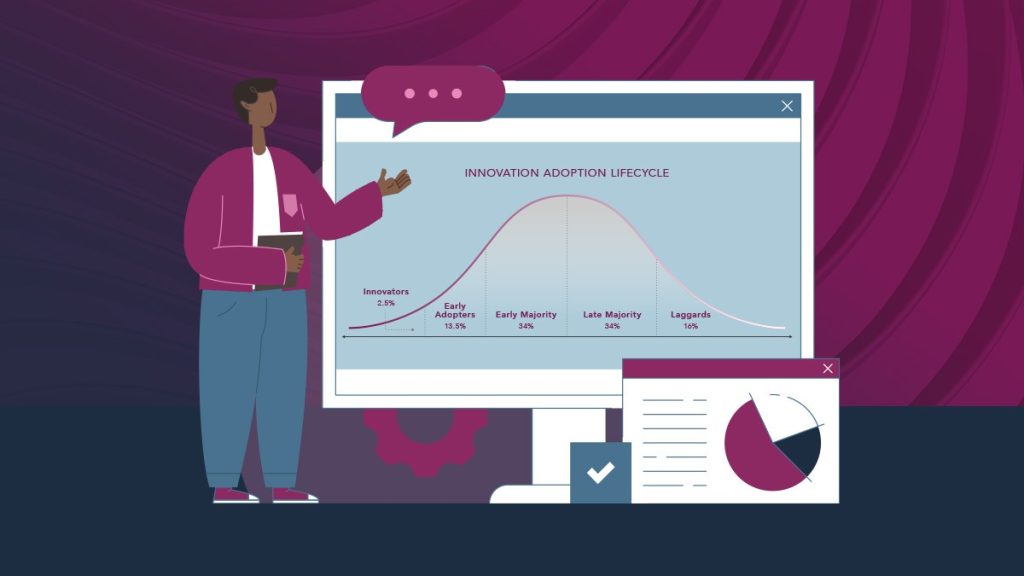Diffusion of Innovations Theory, developed by Everett Rogers in 1962, explains how new ideas and technologies spread within societies. This theory focuses on the adoption process, identifying key factors that influence how innovations are communicated and embraced by individuals and organizations. By understanding Diffusion of Innovations Theory, businesses and policymakers can develop strategies to accelerate the adoption of new products and practices, ensuring their successful integration into the market.
The Key Elements of Diffusion of Innovations Theory
Diffusion of Innovations Theory encompasses five key elements: the innovation itself, communication channels, time, the social system, and the innovation-decision process. These elements interact to determine the rate and success of adoption. The innovation itself refers to the new idea, product, or practice being introduced. Its perceived attributes, such as relative advantage, compatibility, complexity, trialability, and observability, significantly influence adoption.
Moreover, communication channels are crucial in spreading information about the innovation. Mass media, interpersonal networks, and social media all play vital roles in disseminating knowledge and shaping perceptions. Effective communication can accelerate the diffusion process by increasing awareness and understanding of the innovation.
Additionally, time is a critical factor in Diffusion of Innovations Theory. The adoption process occurs over time, with different groups of individuals adopting at various stages. Rogers identifies five adopter categories: innovators, early adopters, early majority, late majority, and laggards. Each group has distinct characteristics and adoption behaviors, influencing the overall diffusion rate.
Furthermore, the social system within which the innovation is introduced affects its adoption. Cultural norms, social structures, and network connections all play significant roles in how innovations spread. Understanding the social context helps in tailoring communication strategies and addressing potential barriers.
Finally, the innovation-decision process outlines the stages individuals go through when adopting an innovation. This process includes knowledge, persuasion, decision, implementation, and confirmation. By addressing each stage, businesses can develop targeted interventions to facilitate adoption and overcome resistance.
Benefits of Diffusion of Innovations Theory
Diffusion of Innovations Theory offers numerous benefits for understanding and facilitating the adoption of new ideas and technologies. One of the primary advantages is its comprehensive framework. By considering multiple factors, this theory provides a holistic understanding of the diffusion process. This comprehensive approach helps identify critical leverage points for accelerating adoption.
Moreover, Diffusion of Innovations Theory highlights the importance of tailored communication strategies. Different adopter groups respond to different types of information and persuasion tactics. By customizing communication efforts to suit the preferences and needs of each group, businesses can enhance the effectiveness of their marketing and outreach campaigns.
Additionally, this theory emphasizes the role of social influence and networks. Understanding how social connections and peer interactions impact adoption decisions can inform strategies for leveraging influencers and opinion leaders. Engaging these key individuals can significantly enhance the credibility and acceptance of the innovation.
Furthermore, Diffusion of Innovations Theory underscores the need for ongoing support and reinforcement. Adoption is not a one-time event but a process that requires continuous engagement and encouragement. Providing resources, training, and positive reinforcement helps sustain adoption and ensure long-term success.
Business Applications
Applying Diffusion of Innovations Theory in business involves strategic planning and targeted interventions. Organizations must start by thoroughly understanding the innovation and its perceived attributes. This involves conducting market research to identify the relative advantage, compatibility, complexity, trialability, and observability of the innovation. By addressing these attributes, businesses can enhance the appeal and acceptability of the new product or practice.
Moreover, businesses should develop a multi-channel communication strategy. This strategy should leverage mass media, social media, and interpersonal networks to disseminate information and engage potential adopters. Tailoring messages to different adopter groups ensures that communication efforts resonate with each audience segment.
Additionally, identifying and engaging early adopters is crucial. Early adopters are typically more open to new ideas and can influence subsequent adopter groups. By building strong relationships with early adopters, businesses can create a ripple effect that accelerates the overall diffusion process. Providing exclusive access, incentives, and support to early adopters can enhance their commitment and advocacy.
Furthermore, businesses must address potential barriers to adoption. This involves understanding the social system and cultural context in which the innovation is introduced. Identifying and mitigating resistance, whether due to cultural norms, economic factors, or perceived risks, is essential for successful adoption. Developing targeted interventions, such as training programs, demonstrations, and pilot projects, can help overcome these barriers.
Finally, businesses should monitor and support the adoption process continuously. This involves providing ongoing resources, training, and reinforcement to ensure that adopters feel confident and capable of using the innovation. By maintaining engagement and offering positive reinforcement, businesses can sustain adoption and achieve long-term success.
Challenges in Using Diffusion of Innovations Theory
Despite its many benefits, using Diffusion of Innovations Theory can present challenges. One common obstacle is accurately assessing the perceived attributes of the innovation. Conducting thorough market research and obtaining honest feedback can be difficult but is crucial for understanding how potential adopters perceive the innovation.
Additionally, developing effective communication strategies can be complex. Different adopter groups have varying preferences and information needs. Crafting messages that resonate with each group requires a deep understanding of their characteristics and motivations. Businesses must invest time and resources in understanding their target audiences.
Furthermore, engaging early adopters and leveraging social networks requires strategic effort. Identifying key influencers and building relationships with them can be time-consuming. Businesses must be proactive and persistent in their engagement efforts to harness the power of social influence effectively.
Moreover, sustaining adoption over the long term can be challenging. Continuous support and reinforcement are essential, but they require ongoing resources and commitment. Businesses must remain vigilant and proactive in their efforts to ensure that adopters do not revert to old practices.
Conclusion
Diffusion of Innovations Theory provides a valuable framework for understanding and facilitating the adoption of new ideas and technologies. By considering the innovation itself, communication channels, time, the social system, and the innovation-decision process, businesses can develop comprehensive strategies to accelerate adoption. This theory emphasizes the importance of tailored communication, social influence, and ongoing support.
In conclusion, mastering Diffusion of Innovations Theory is essential for businesses seeking to introduce and sustain new innovations successfully. By applying the core principles and integrating them into strategic planning, companies can enhance their ability to innovate and achieve long-term success. Embrace Diffusion of Innovations Theory to develop effective adoption strategies, support continuous improvement, and drive organizational growth. Understanding and applying this theory empowers organizations to navigate the complexities of innovation and achieve their strategic goals.


